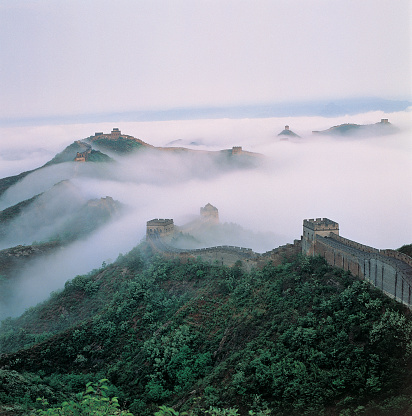
The Great Wall of China
 While the Great Wall of China is not one of the Seven Wonders of the Ancient World, it is typically included in the Seven Wonders of the Medieval World. The Great Wall is a single continuous wall built at once is a myth. The wall is a network of wall segments built by variuos dynasties ot protect China's northern boundary. During its construction , the Great Wall was called "the longest cemetery on earth because so many people died building it. The main wall is around 2145 miles long with an extra 1770 miles of branches and spurs. The most visited section of the Great Wall is in Badaling, close to Beijing, which was built during the Ming Dynasty. It was the first section to open to tourists in 1957.Theearliest extensive walls were built by the Quin Shi Huang of the Quin dynasty, who first unified China and is most famous for the standing terra cotta army left to guard his tomb.The dynasties after the Qin which added and rebuilt the Great Wall were the Han, Sui, Jin and Ming. What survives today are the walls from the Ming dynasty.
While the Great Wall of China is not one of the Seven Wonders of the Ancient World, it is typically included in the Seven Wonders of the Medieval World. The Great Wall is a single continuous wall built at once is a myth. The wall is a network of wall segments built by variuos dynasties ot protect China's northern boundary. During its construction , the Great Wall was called "the longest cemetery on earth because so many people died building it. The main wall is around 2145 miles long with an extra 1770 miles of branches and spurs. The most visited section of the Great Wall is in Badaling, close to Beijing, which was built during the Ming Dynasty. It was the first section to open to tourists in 1957.Theearliest extensive walls were built by the Quin Shi Huang of the Quin dynasty, who first unified China and is most famous for the standing terra cotta army left to guard his tomb.The dynasties after the Qin which added and rebuilt the Great Wall were the Han, Sui, Jin and Ming. What survives today are the walls from the Ming dynasty.
DRUM TOWER & BELL TOWER
The Drum Tower originally marked the center of the old Mongol capital. The drums of this later Ming-dynasty version were beaten to mark the hours of the day. The steep steps will give you an impressive view of Beijing;s hutong rooftops. Drum performances are given hourly from 94=30am to 1130am and from 130pm to 450pm.
The Bell Tower originally dates from Ming times. The Ming structure went up in a sheet of flames and the present structure is a Qing edifice dating from the 18th century.Enjoy drinks at the Drum and Bell bar.
The Summer Palace
The Summer Palace was the playground for emperors fleeing the summer of the old imperial city. It merits an entire day to explore the temples, gardens, pavilions, bridges and corridors. The domain had been a royal garden before being enlarged and embellished by Emperor Qianlong in the 18th century. Sparkling Kunming Lake swallows up 3/4 of the park, overlooked by Longevity Hill. The principle structure is the Hall of Benevolence and Longevity, housing a hardwood throne and attached courtyard decorated with bronze animals. The Long Corridor is trimmed with a plethora of paintings, while the slopes of Longevity Hill are filled with Buddhist temples. Crowning the peak is the Buddhist Temple of the Sea of Wisdom tiled with effigies of Buddha, many with no heads. A good cardiovascular workout would take you along the West Causeway to return along the East shore. The views are gorgeous.
